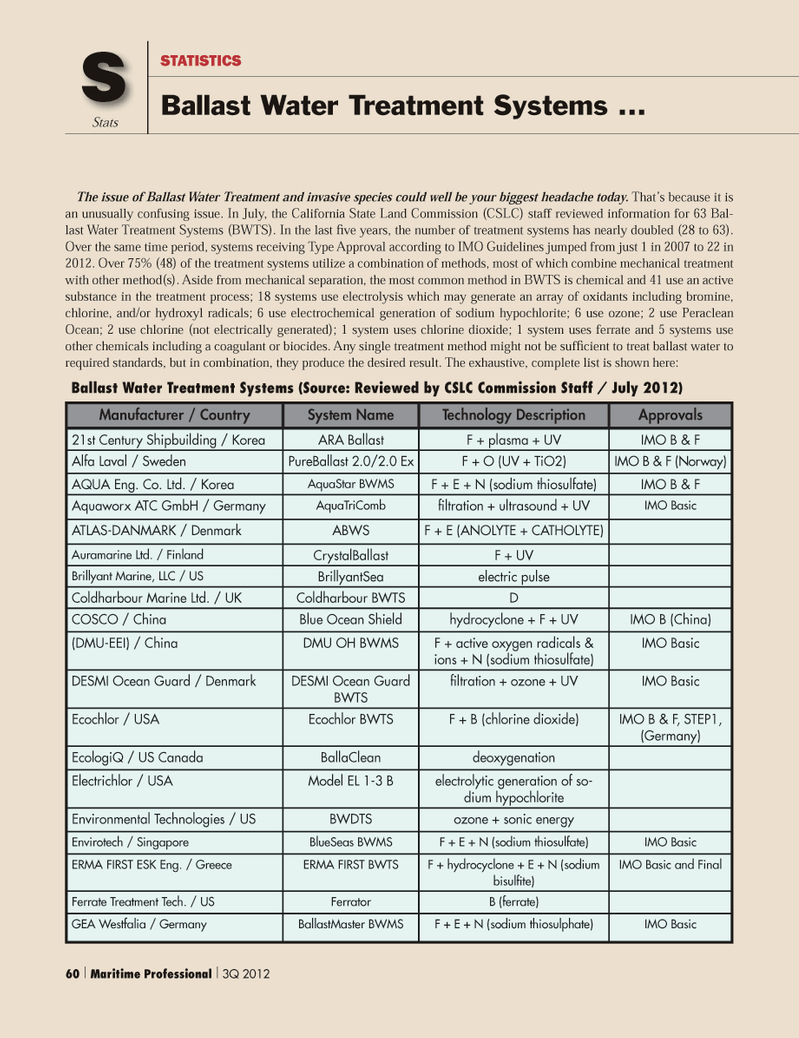
Page 60: of Maritime Logistics Professional Magazine (Q3 2012)
Classification Societies, Quality & Design
Read this page in Pdf, Flash or Html5 edition of Q3 2012 Maritime Logistics Professional Magazine
StatsSTATISTICS Ballast Water Treatment Systems ... SThe issue of Ballast Water Treatment and invasive species could well be your biggest headache today. That?s because it is an unusually confusing issue. In July, the California State Land Commission (CSLC) staff reviewed information for 63 Bal- last Water Treatment Systems (BWTS). In the last ve years, the number of treatment systems has nearly doubled (28 to 63). Over the same time period, systems receiving Type Approval according to IMO Guidelines jumped from just 1 in 2007 to 22 in 2012. Over 75% (48) of the treatment systems utilize a combination of methods, most of which combine mechanical treatment with other method(s). Aside from mechanical separation, the most common method in BWTS is chemical and 41 use an active substance in the treatment process; 18 systems use electrolysis which may generate an array of oxidants including bromine, chlorine, and/or hydroxyl radicals; 6 use electrochemical generation of sodium hypochlorite; 6 use ozone; 2 use Peraclean Ocean; 2 use chlorine (not electrically generated); 1 system uses chlorine dioxide; 1 system uses ferrate and 5 systems use other chemicals including a coagulant or biocides. Any single treatment method might not be suf cient to treat ballast water to required standards, but in combination, they produce the desired result. The exhaustive, complete list is shown here: Ballast Water Treatment Systems (Source: Reviewed by CSLC Commission Staff / July 2012) Manufacturer / CountrySystem NameTechnology DescriptionApprovals 21st Century Shipbuilding / Korea ARA Ballast F + plasma + UV IMO B & F Alfa Laval / Sweden PureBallast 2.0/2.0 Ex F + O (UV + TiO2) IMO B & F (Norway) AQUA Eng. Co. Ltd. / Korea AquaStar BWMS F + E + N (sodium thiosulfate) IMO B & F Aquaworx ATC GmbH / Germany AquaTriComb Þ ltration + ultrasound + UV IMO Basic ATLAS-DANMARK / Denmark ABWS F + E (ANOLYTE + CATHOLYTE) Auramarine Ltd. / Finland CrystalBallast F + UV Brillyant Marine, LLC / US BrillyantSea electric pulse Coldharbour Marine Ltd. / UKColdharbour BWTS D COSCO / ChinaBlue Ocean Shield hydrocyclone + F + UV IMO B (China) (DMU-EEI) / ChinaDMU OH BWMS F + active oxygen radicals & ions + N (sodium thiosulfate) IMO Basic DESMI Ocean Guard / DenmarkDESMI Ocean Guard BWTS Þ ltration + ozone + UV IMO Basic Ecochlor / USAEcochlor BWTS F + B (chlorine dioxide) IMO B & F, STEP1, (Germany) EcologiQ / US Canada BallaClean deoxygenation Electrichlor / USA Model EL 1-3 B electrolytic generation of so- dium hypochlorite Environmental Technologies / US BWDTS ozone + sonic energy Envirotech / Singapore BlueSeas BWMS F + E + N (sodium thiosulfate) IMO Basic ERMA FIRST ESK Eng. / Greece ERMA FIRST BWTS F + hydrocyclone + E + N (sodium bisulÞ te)IMO Basic and Final Ferrate Treatment Tech. / US Ferrator B (ferrate) GEA Westfalia / Germany BallastMaster BWMS F + E + N (sodium thiosulphate) IMO Basic 60 | Maritime Professional | 3Q 2012

 59
59

 61
61
